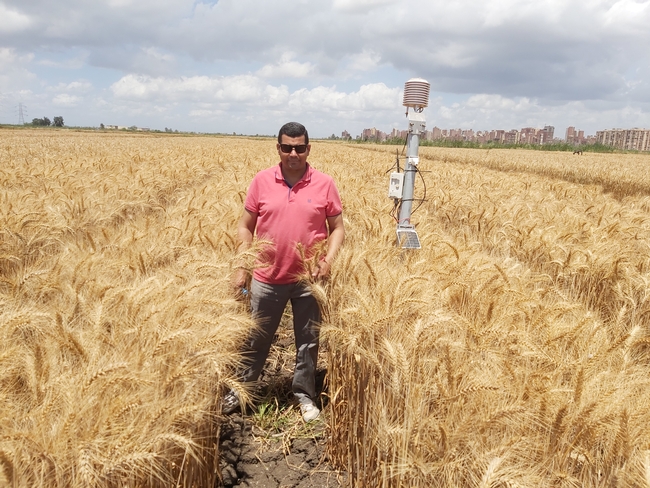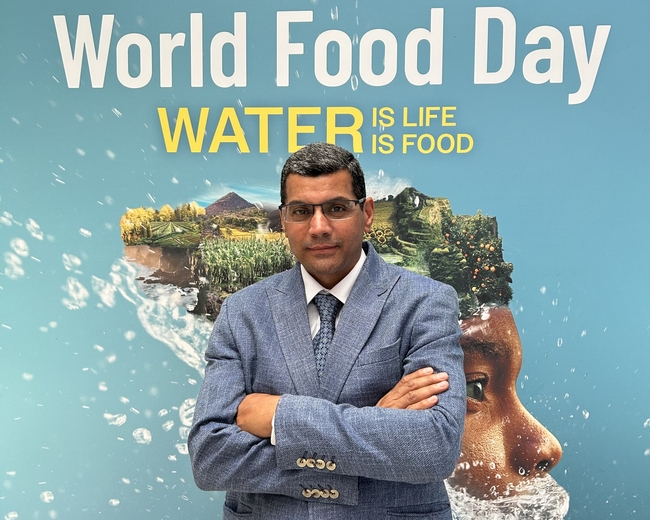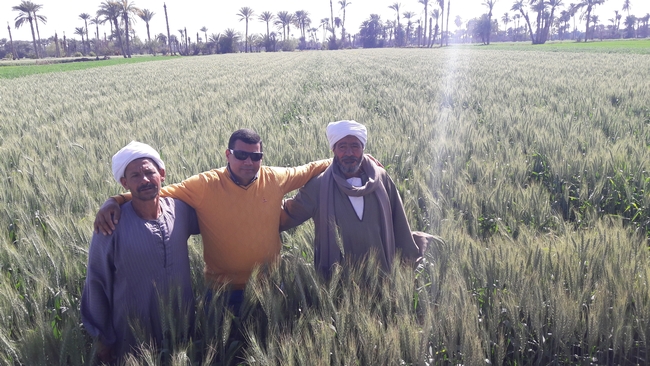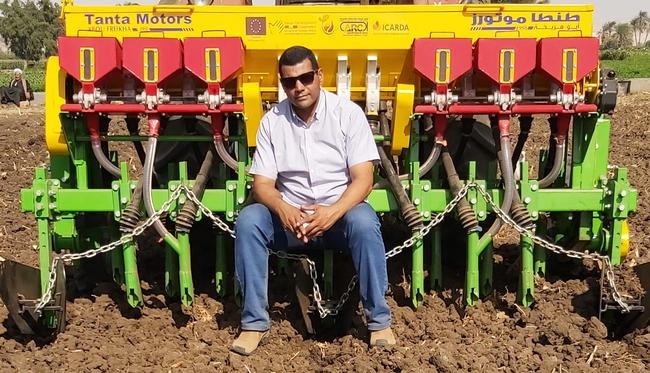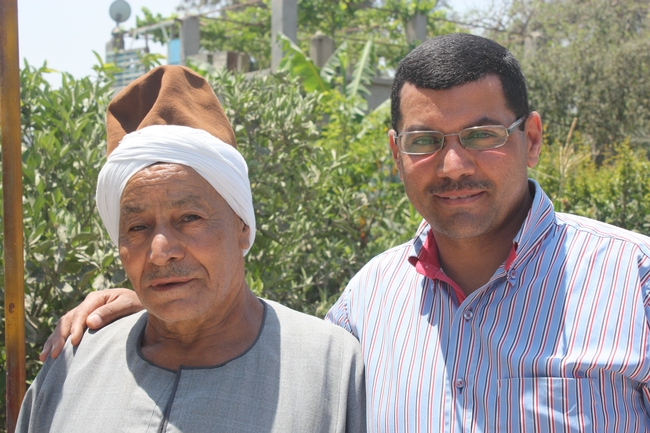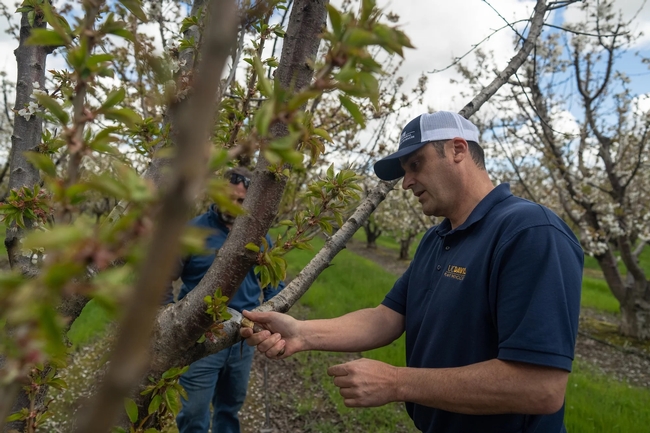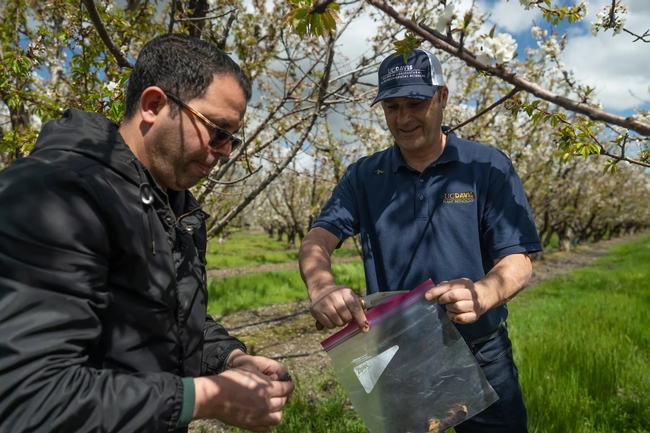Posts Tagged: Kearney REC
Lawn-pocalypse! Surviving Drought
Ah, summer! The season of sunburns, pool parties, and… lawn droughts. If your once lush, green carpet now looks like a crunchy brown doormat, you're not alone. Let's dive into why your yard is staging a dramatic death scene and what you can do to...

Bermuda grass and weeds overtaking drought stressed turf grass.
From Sharqia to Rome to Fresno: Renowned irrigation expert comes to UC ANR
Atef Swelam begins as director of Kearney and West Side Research and Extension Centers
In the fields around the Egyptian city of Minya Al-Qamh, “port of wheat” in Arabic, a boy rubbed his eyes wearily as he helped his father irrigate their crops at 2 a.m. – when they could access the scarce water that reached their farm, located at the tail end of the canal. The family, which had been farming the land around the village of Sharqia for many generations, barely had enough water to sustain their wheat and vegetables.
Swatting in the darkness at the incessantly biting mosquitoes, a young Atef Swelam made a vow.
“I said: ‘I will do my best to not let anyone suffer like I have suffered, like my father suffered – I will help to improve the lives of others,'” recalled Swelam, who went on to become an irrigation engineer improving water-use efficiency.
During the World Food Forum (Oct. 16-20), Swelam was recognized by the United Nations' Food and Agriculture Organization as a “Water and Food Hero” for developing irrigation techniques that save water and boost yields across the Nile Delta and beyond.
Swelam started on Aug. 10 as director of both the Kearney Agricultural Research and Extension Center in Parlier and the West Side REC in Five Points. Both facilities are part of a network of centers operated by University of California Agriculture and Natural Resources.
“Our organization, and more importantly the communities we serve in the Central Valley and across California, are so fortunate that Atef has joined our team,” said Brent Hales, UC ANR associate vice president for research and Cooperative Extension. “He brings not only a record of truly impactful research and innovation but a genuine passion for learning the needs of people, working with them and developing collaborative, science-based solutions.”
Making a difference in the lives of people
After earning his master's degree in land and water management from the Mediterranean Agronomic Institute of Bari in Italy, Swelam returned to Egypt for his Ph.D. in agricultural engineering at Zagazig University. There, he advanced to become a professor of irrigation and drainage engineering in 2019; he was also a senior scientist and research team leader with the International Center for Agricultural Research in the Dry Areas (CGIAR-ICARDA). Most recently, Swelam was the agricultural research officer of the U.N.-FAO's Office of Innovation in Rome.
Swelam explained that the mandate, function, mission and vision of UC ANR's research and extension network – and its strong reputation for making an impact through co-creation with clientele – attracted him to this position in California.
“I'm always looking to make a difference on the ground and in the lives of people,” he said. “If you look at the locations where all RECs are located, they are inside the communities themselves, and in the heart of the farming system.”
Swinging between Kearney and West Side RECs, Swelam said he feels he works in an empowering environment, created and supported by the leadership as well as by the staff at both centers – “a dynamic is which hard to find elsewhere.”
Darren Haver, recently named director of the statewide system of RECs, said he will work with Swelam to explore ways to secure the resources that the Kearney and West Side teams need.
“Atef brings a wealth of experience in conducting research as well as working to elevate and amplify the research and outreach of others,” said Haver, formerly the director of South Coast REC in Irvine. “He clearly is committed to making a difference locally, nationally and globally and we are excited to support him as his vision for these two RECs evolves.”
Being a farmer and a scientist, Swelam feels he is on the same wavelength with both of the RECs' clientele groups – researchers and growers. In his first months on the job, Swelam said he will get to know the needs of the grower community and the researchers at the RECs.
“What I like most about this job is that the REC system, with its research for development approach, supports the scientists, who are in turn supporting the farmers and communities that are on the front line in achieving food and nutrition security,” he explained.
When tailoring solutions to meet local conditions, Swelam added that it's essential that community members are involved so they feel a sense of ownership and are committed to sustaining its impact beyond the time limits of a research or extension project.
Innovative irrigation technique used worldwide
A prominent example of Swelam's community-based work is his long-term mechanized raised-bed (MRB) irrigation program, the technology for which he has garnered numerous international honors.
While he was a researcher at the CGIAR-ICARDA, Swelam led several projects between 2010 and 2020 to study new soil and water practices at farm level. Through a project at his home village, he developed a cost-effective, small-scale machine to enable growing wheat on raised beds. This was in contrast to flat flooded land – the traditional, labor- and resource-intensive method that produced irrigation inefficiencies and caused shortages for downstream farmers like his father, Haj Ibrahim.
With MRB, precisely placed trenches between the raised beds would hold exactly the amount of water the adjacent crops need and thus leave more water for all. And while the technique seemed promising, Swelam had to convince skeptical farmers to adopt the practices – including his neighbors and his own father.
“He was very resistant to me in the beginning, because this was the first time ever in Egypt using raised beds for wheat cultivation…he even tried to convince people not to follow me,” Swelam said, with a chuckle.
So father and son divided their fields, with one half planted and irrigated using traditional methods, and the other using the raised-bed approach. Gradually, as MRB began to prove its worth, Haj Ibrahim warmed to the technology and became an active collaborator on the research – even helping the scientist when he was puzzled by experiment results.
“My father was my mobile library,” Swelam said. “He was illiterate – he had never been in a school – but his thinking and knowledge about the real agriculture and farming system were much better than those of a professor like me!”
After the initial research trials produced successes in his village and the larger governorate (a political division within Egypt), the technique was replicated in other governorates across the country – which then attracted the attention of other nations and international organizations.
Overall, Swelam said, the technology helped the growers reduce applied water by 25% and cut farming costs by 25%, while boosting fertilizer use efficiency by 30% and increasing yield by 25%.
Today, MRB is applied by more than 2 million farmers in the Middle East and North Africa to a variety of crops and is recognized as a good agricultural practice by the U.N. Food and Agriculture Organization.
“The biggest recognition and reward for me out of this impactful innovation is seeing the smiles on the faces of farmers,” Swelam said.
Spreading best practices across San Joaquin Valley and beyond
Swelam said he hopes to see similarly positive results for farmers here in California with a wide range of innovations. He and other researchers at Kearney and West Side RECs will continue to make sure that the science and knowledge generated at the centers reach farmers. He added that partnering with local growers to optimize their on-farm practices is crucial on a host of issues, from pest management to water conservation.
“Whatever we do to improve supply management at system level, if the water is not used efficiently at farm level, then we lose everything we had achieved at that macro level,” he explained.
Swelam added that investing intensive time and effort in developing practical, cost-effective solutions will pay off in the long run as they become naturally adopted across the grower community.
“Farmers are very clever and skilled with their farming systems,” he said. “When they see or get benefits from something, they promote it among themselves.”
Swelam's father was one example. After leading the resistance against mechanized raised beds initially, he eventually became its most vocal proponent.
“He became the biggest promoter for this technology; he even promoted it on local and international TV and radio programs,” Swelam said. “I was proud of my father.”
Haj Ibrahim died in 2017 and Swelam continues to pay tribute to his father through his life's work on research and extension – inspired by their long struggles to bring water to their crops, and the shared triumph of their new techniques.
Winter atmospheric rivers gave pathogens, diseases path to infect crops
Outbreaks similar to El Niño-influenced issues of the 1990s
The wave of atmospheric rivers that swept across the state this winter has created the right conditions for plant pathogens that haven't been seen for decades in California. University of California, Davis, plant pathologist Florent “Flo” Trouillas is getting more calls from growers and farm advisors concerned about potential crop damage.
“Generally, whenever you have rain events, you're going to have problems,” said Trouillas, a Cooperative Extension specialist who is based at the Kearney Agricultural Research and Extension Center in Parlier. “In wet years we get really busy because most pathogens need and like water.”
Trouillas is like a disease detective. He splits his time between the field and the lab, working to diagnose pathogens, diseases and other ailments that strike fruit and nut crops such as almonds, cherries, olives and pistachios.
On a recent visit to an almond orchard near Fresno, Trouillas joined Mae Culumber, a nut crops farm advisor for UC Cooperative Extension Fresno County. A few weeks earlier, the two had walked the orchard, taking note of the base of some trees that had gumming — a thick, jelly-looking substance indicating a pathogen had taken hold.
“A lot of what Florent is doing is trying to assess patterns on a landscape,” Culumber said. “Sometimes things may look like they are one thing, but it could be another problem.”
When the two returned weeks later, the amber-colored gumming had moved into the canopy, looking like gumballs stuck to branches, some of which were already dead. “It's getting out of control from before,” Trouillas says. “This branch was killed. This is widespread.”
From the field to the lab
Lab testing confirmed what Trouillas believed was the culprit: Phytophthora syringae, a pathogen that can affect almond crops but is rarely seen in California. If it is found, generally the site of infection are wounds caused by pruning, but that is not the case here, where the infection began in the canopy at twigs, or small branches.
It is a threat to a key crop, which according to the California Department of Food and Agriculture, generates $5 billion annually. The last time Phytophthora syringae hit California was in the 1990s after a series of El Niño-influenced storms. Trouillas, who has a photographic memory, remembered reading about it in an old manual.
“It's rare for California and one that we see mostly following atmospheric rivers,” he says.
“The disease will only happen following these extremely wet winters.”
Phytophthora is soilborne, mostly found in tree roots, and doesn't generally spread up into branches. But the intense storms created the right conditions for the pathogen to “swim” up trunks as winds blew spores into the air and rain dropped them back down into the canopy, Trouillas said.
Some of the trees in this orchard will die; others can be saved by pruning infected branches and applying a recommended fungicide, he said.
Identification, diagnosis, education
Trouillas is one of more than 50 Cooperative Extension specialists at UC Davis and each is charged with identifying problems and developing solutions for those issues in support of agriculture, the ecosystem and communities throughout the state.
In his role, Trouillas focuses not only on pathology and research but also on educating growers, nursery staff, pest control advisers and others in agriculture about ways to manage potential threats and how to prevent crop damage.
“His role is very crucial,” said Mohammad Yaghmour, an orchard systems advisor for UC Cooperative Extension Kern County. “He's not only on this mission to educate growers but he's also a source of education for us.”
Trouillas typically conducts one or two site visits a week, usually after a farm advisor reaches out about a problem they can't solve on their own.
“This allows us to be at the forefront of disease detections in California,” he said.
He likens these visits to house calls a doctor would make, only to fields instead. And one of those calls recently took him to a cherry orchard in Lodi.
“These guys help me quite a bit,” said Andrew Vignolo, a pest control adviser with Wilbur-Ellis who asked for a consult. “I bug them a lot.”
The visit starts like any consult in a doctor's office, only the questions come fast as they walk around the Lodi orchard where branches are dying, there is gumming and the trees appear stressed. Some look to be sunburned from exposure. Old pruning wounds show cankers, indicating that past disease treatments didn't get rid of whatever was affecting the trees.
Trouillas asks about the cultivar of the trees because some varieties are more susceptible to pests or diseases. He focuses on stress because that opens the door to disease.
Do they prune in the dormant winter months or in summer when pathogens are more prevalent? Does the soil get tested? How old are the trees? What about nutrition?
“I'm trying to figure out how they got infected so bad,” Trouillas said, walking the orchard. “Bacterial canker is a very mysterious disease.”
He thinks it might be a bacterial canker disease and shaves some bark to take to the lab for testing. He wants to come back next winter to take some samples to see where the pathogen is overwintering.
“We'll know in a few weeks if we have a fighting chance,” Vignolo said.
Be it Lodi, Fresno or elsewhere in the state, Trouillas focuses on local conditions. But what is learned in one field can be passed on to others, providing early warnings or advice for those in similar situations. “All these efforts at collaboration, from the field, to the lab, going through research projects, there's only one goal here — to help the farmers of California.”
Climate-Change Resources
University of California UC ANR Green Blog (Climate Change and Other Topics) https://ucanr.edu/blogs/Green/index.cfm?tagname=climate%20change (full index)
Examples:
- Save Trees First: Tips to Keep Them Alive Under Drought https://ucanr.edu/b/~CdD
- Landscaping with Fire Exposure in Mind: https://ucanr.edu/b/~G4D
- Cities in California Inland Areas Must Make Street Tree Changes to adapt to Future Climate https://ucanr.edu/b/~oF7
Drought, Climate Change and California Water Management Ted Grantham, UC Cooperative Extension specialist (23 minutes) https://youtu.be/dlimj75Wn9Q
Climate Variability and Change: Trends and Impacts on CA Agriculture Tapan Pathak, UC Cooperative Extension specialist (24 minutes) https://youtu.be/bIHI0yqqQJc
California Institute for Water Resources (links to blogs, talks, podcasts, water experts, etc.) https://ciwr.ucanr.edu/California_Drought_Expertise/
UC ANR Wildfire Resources (publications, videos, etc.) https://ucanr.edu/News/For_the_media/Press_kits/Wildfire/ (main website)
-UC ANR Fire Resources and Information https://ucanr.edu/sites/fire/ (main website)
-Preparing Home Landscaping https://ucanr.edu/sites/fire/Prepare/Landscaping/
UC ANR Free Publications https://anrcatalog.ucanr.edu/ (main website)
- Benefits of Plants to Humans and Urban Ecosystems: https://anrcatalog.ucanr.edu/pdf/8726.pdf
-Keeping Plants Alive Under Drought and Water Restrictions (English version) https://anrcatalog.ucanr.edu/pdf/8553.pdf
(Spanish version) https://anrcatalog.ucanr.edu/pdf/8628.pdf
- Use of Graywater in Urban Landscapes https://anrcatalog.ucanr.edu/pdf/8536.pdf
- Sustainable Landscaping in California https://anrcatalog.ucanr.edu/pdf/8504.pdf
Other (Non-UC) Climate Change Resources
Urban Forests and Climate Change. Urban forests play an important role in climate change mitigation and adaptation. Active stewardship of a community's forestry assets can strengthen local resilience to climate change while creating more sustainable and desirable places to live. https://www.fs.usda.gov/ccrc/topics/urban-forests
Examining the Viability of Planting Trees to Mitigate Climate Change (plausible at the forest level) https://climate.nasa.gov/news/2927/examining-the-viability-of-planting-trees-to-help-mitigate-climate-change/
Reports and other information resources coordinated under the auspices of the United Nations and produced through the collaboration of thousands of international scientists to provide a clear and up to date view of the current state of scientific knowledge relevant to climate change. United Nations Climate Action
Scientific reports, programs, action movements and events related to climate change. National Center for Atmospheric Research (National Science Foundation)
Find useful reports, program information and other documents resulting from federally funded research and development into the behavior of the atmosphere and related physical, biological and social systems. Search and find climate data from prehistory through to an hour ago in the world's largest climate data archive. (Formerly the "Climatic Data Center") National Centers for Environmental Information (NOAA)
Think tank providing information, analysis, policy and solution development for addressing climate change and energy issues (formerly known as the: "Pew Center on Global Climate Change"). Center for Climate & Energy Solutions (C2ES)
Mapping Resilience: A Blueprint for Thriving in the Face of Climate Disaster. The Climate Adaptation Knowledge Exchange (CAKE) was launched in July 2010 and is managed by EcoAdapt, a non-profit with a singular mission: to create a robust future in the face of climate change by bringing together diverse players to reshape planning and management in response to rapid climate change. https://www.cakex.org/documents/mapping-resilience-blueprint-thriving-face-climate-disaster
Cal-Adapt provides a way to explore peer-reviewed data that portrays how climate change might affect California at the state and local level. We make this data available through downloads, visualizations, and the Cal-Adapt API for your research, outreach, and adaptation planning needs. Cal-Adapt is a collaboration between state agency funding programs, university and private sector researchers https://cal-adapt.org/
Find reports, maps, data and other resources produced through a confederation of the research arms of 13 Federal departments and agencies that carry out research and develop and maintain capabilities that support the Nation's response to global change. Global Change (U.S. Global Change Research Program)
The Pacific Institute is a global water think tank that combines science-based thought leadership with active outreach to influence local, national, and international efforts to develop sustainable water policies. https://pacinst.org/our-approach/
Making equity real in climate adaptation and community resilience policies and programs: a guidebook. https://greenlining.org/publications/2019/making-equity-real-in-climate-adaption-and-community-resilience-policies-and-programs-a-guidebook/
Quarterly CA Climate Updates and CA Drought Monitor Maps (updated each Thursday) https://www.drought.gov/documents/quarterly-climate-impacts-and-outlook-western-region-june-2022
Drought focus of Water Resources IMPACT magazine special issue
UC ANR experts address emotional toll of drought
Preparing the American West for prolonged drought is the focus of a double issue of Water Resources IMPACT magazine. The California Water Commission staff are guest editors for this special open-access edition of the magazine, which is published by the American Water Resources Association.
Faith Kearns, academic coordinator of University of California Agriculture and Natural Resources' California Institute for Water Resources, is among the authors delving into how drought impacts people and the environment and how we can better prepare for the inevitable.
The first issue, published on Feb. 14, focuses on water scarcity issues confronting California and the ways these issues affect different sectors.
In “Trauma, Care, and Solidarity: Addressing the Emotional Toll of Chronic Drought,” Kearns highlights the effects of drought on mental health. She points to the spike in suicide hotline calls when wells ran dry in Southeast Asian communities in California's Central Valley.
By listening to Southeast Asian farmers, Ruth Dahlquist-Willard and Michael Yang of UC Cooperative Extension were able to “lighten the load” for them by providing pragmatic support, Kearns writes.
“The scale of some of these highly emotional issues – drought, wildfires, climate change – can make them seem incredibly difficult, if not impossible, to deal with,” Kearns said. “At the same time, they are affecting everyone living in the western U.S. on a daily basis. I wanted to highlight and provide models based on work that people – whether they are researchers, clinical psychologists, or Cooperative Extension advisors – are doing right now to ease the way.”
The authors who contributed to the double issue are a diverse array of Tribal experts, academics, nongovernmental organization thought-leaders, water managers and water policy influencers, each of whom brings their own perspective on the topic of drought. Their expertise and perspectives in climate science, water policy and water management will help inform drought-related decision-making and support policies that better prepare the state to thrive during periods of prolonged water scarcity.
In addition to Kearns, the first issue includes articles contributed by:
- Samantha Stevenson, University of California, Santa Barbara
- Jay Lund, University of California, Davis
- Ron Goode, North Fork Mono Tribe
- Andy Fecko, Placer County Water Agency
- Jeff Mount, Public Policy Institute of California, and Ted Grantham, University of California, Berkeley/UC Cooperative Extension
- Nat Seavy and Karyn Stockdale, National Audubon Society
- Kjia Rivers, Community Water Center
- Cannon Michael, Bowles Farming
- Michelle Reimers, Turlock Irrigation District
The January/February edition of Water Resources IMPACT magazine can be accessed, free of charge, on the American Water Resources Association website at https://www.awra.org under “Publications.”
The second issue, to be published in March, will focus on drought response, considering the options for adaptation. This two-part series complements the Commission's work on strategies to protect communities and fish and wildlife in the event of a long-term drought.

